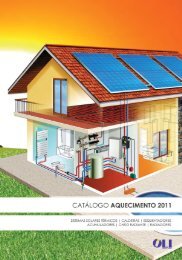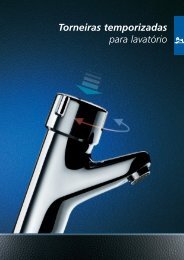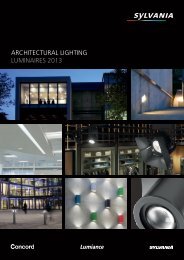TMS DORMA - Quadri Sistemas
TMS DORMA - Quadri Sistemas
TMS DORMA - Quadri Sistemas
Create successful ePaper yourself
Turn your PDF publications into a flip-book with our unique Google optimized e-Paper software.
<strong>DORMA</strong> <strong>TMS</strong> Safety information<br />
<strong>TMS</strong>, GB<br />
<strong>DORMA</strong> emergency exit systems are designed, developed<br />
and manufactured in accordance with the latest state of the<br />
art and in line with recognised technical safety regulations<br />
and standards.<br />
They meet the requirements of the code of practice entitled<br />
“Requirements for electrical locking systems on doors in<br />
emergency escape routes” (EltVTR, December 1997 edition)<br />
published in Bulletin 5/98 of the German Institute for<br />
Building Technology, Berlin.<br />
Test and approval certificates issued by the MPA NRW<br />
(Material Testing Authority) and VdS Cologne (Association of<br />
Property Insurers) are available.<br />
Compliance with the following instructions by the<br />
installer and operator is imperative to ensuring that<br />
these devices do not impede unhindered escape of<br />
persons in the event of a hazard-related emergency.<br />
Usage<br />
Emergency exit systems are electrical locking systems for<br />
doors in emergency exits and escape routes. They are<br />
designed in order to prevent improper or unauthorised usage<br />
of the associated access points.<br />
When installing and using <strong>DORMA</strong> emergency exit systems,<br />
compliance with the technical data and the requirements<br />
emanating from prevailing local conditions is essential.<br />
Preliminary building enquiry / Planning application /<br />
Approval procedure – The German example –<br />
Emergency exit systems do not fall under the compass of<br />
current building law and approval is subject to a discretionary<br />
exemption in the sense of § 67 Musterbauordnung<br />
[Outline building regulations].<br />
In addition, the requirements according to DIBt 5/98 should<br />
also be regarded as ancillary regulations that need to be<br />
incorporated within the building approval process for the<br />
project in hand.<br />
Planning and installation<br />
A <strong>DORMA</strong> emergency exit system consists at least of the<br />
components <strong>TMS</strong> door terminal/central control station and<br />
TV electrical door locking element. Depending on the design<br />
of the emergency exit control, the following components may<br />
also be connected to the system: Key switch or access control<br />
system, monitoring and control unit, emergency escape<br />
lock with automatic locking action (switch-monitored or<br />
motor lock), flashing lamp or external alarm siren, automatic<br />
swing door operator, power pack with emergency power<br />
supply, fire alarm and/or hazard alert system, smoke switch.<br />
The electrical door locking element may only be<br />
used on emergency exit doors in conjunction with<br />
products approved by <strong>DORMA</strong>.<br />
The door terminal (local system release/emergency opening<br />
of door) should be mounted in the immediate vicinity of the<br />
door handle so that the centre of the emergency pushbutton<br />
is at a height of 850 mm to max. 1200 mm above the<br />
finished floor level.<br />
The emergency pushbutton must be indicated with an<br />
adhesive label showing the inscription “Emergency Exit”.<br />
The adhesive label should be attached such that the arrow<br />
points to the emergency pushbutton.<br />
In buildings with automatic fire extinguishing equipment, fire<br />
alarm or other hazard alert systems, the emergency exit doors<br />
with electrical anti-tamper protection must be automatically<br />
released for escape on response or activation of these systems.<br />
If, during building usage, there is a constantly manned central<br />
control centre with a direct view of the emergency exit<br />
doors, the emergency exit release/de-activation switching<br />
operation can also be performed from this position.<br />
The properties and characteristics of the fire and smoke<br />
rated doors (fire resistance time, smoke retention/sealing<br />
function and automatic closing action) must not be impaired<br />
by the installation of the electrical door locking device.<br />
In Germany, modifications to fire doors or other fire barriers<br />
which are necessary for the installation of an electrical door<br />
locking element and which go beyond the modifications<br />
indicated as permissible in Bulletin 1/1996 of the DIBt,<br />
require general building approval and/or agreement of the<br />
authorities responsible in each individual case. Consult<br />
local/national authorities for guidance.<br />
Only use <strong>DORMA</strong> spare parts or <strong>DORMA</strong> approved<br />
accessories.<br />
Any work on electrical equipment not operating on<br />
protective low voltage must always be performed by<br />
suitably qualified electricians.<br />
Installation, commissioning and maintenance work<br />
may only be performed by qualified personnel<br />
authorised by <strong>DORMA</strong>.<br />
The keys for the door terminal and emergency exit<br />
control box must be kept secure. Keys for products<br />
not operating on protective low voltage may only be<br />
handed over to suitably qualified electricians.<br />
Standards and regulations<br />
Compliance with all relevant national or regional regulations,<br />
standards, guidelines and directives (latest edition in each<br />
case) must be ensured.<br />
The following publications provide a useful general regulatory<br />
framework for ensuring system safety:<br />
– DIBt bulletin 5/98 – “Requirements for electrical locking<br />
systems on doors in emergency escape routes” (EltVTR),<br />
– DIBt bulletin 1/96 – Modifications to fire doors and fire<br />
rated barriers.<br />
– DIN VDE 0100, 0800, 0815<br />
– Regulations governing the installation of electrical<br />
equipment<br />
– DIN 0833 – Part 1-3<br />
– Regulations governing hazard alert systems for fire,<br />
burglary and robbery detection and alarm<br />
– German building regulations list A, Part 1<br />
– Special building regulations<br />
– prEN 13637 – Building Hardware – Electrically controlled<br />
emergency exit systems<br />
35

















